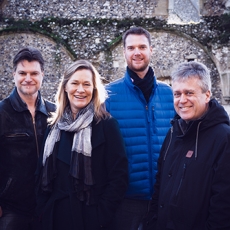Gothic Voices - Mary Star of the Sea - Fanfare
This is something of a departure for Gothic Voices, which has been recording only early music throughout its existence. Three works of Joanne Metcalf (b. 1958) and Andrew Smith (b. 1970) account for four and two tracks (respectively) out of a total of the 22 tracks. Metcalf’s Il nome del bel fior, set to Canto XXIII of Dante’s Paradiso, is divided among three tracks (for three of the seven parts of the whole work), and her Music for the Star of the Sea is the fourth, giving the disc its title. Smith’s Stond wel, moder, under rode is divided into two tracks, which are heard after the Medieval monody. Music for the Star of the Sea is followed by the anonymous Medieval Stella maris, illustrans omnia. The most familiar works are Dunstaple’s Ave maris stella and Beata mater, known on records since Russell Oberlin in 1960 and Syntagma Musicum in 1974 respectively, along with Leonel Power’s Beata progenies, his most familiar work, recorded in the mono era both by Noah Greenberg’s Primavera Singers and by the Deller Consort. The rest of the music is Medieval and early Renaissance.
Gothic Voices recorded Dunstaple’s Beata mater on the disc that featured Missa Veterem hominem (Fanfare 21:1) and the anonymous Tronus regis in The Earliest Songbook (24:3). The anonymous Stond wel, moder, under rode was in Russell Oberlin’s early-stereo English Medieval Songs (18:2 for the CD reissue) and in the Hilliard Ensemble’s Sumer is icumen in (9:6). Crist and Sainte Marie, one of St. Godric’s three songs, is on the same two discs as well as Sequentia’s English Songs of the Middle Ages (12:4). The anonymous Dou way, Robyn is on Melodious Melancholy (30:5). The chant Gaude Maria virgo is well represented in the chant discography. That leaves eight pieces that don’t show up in a casual search.
We have heard many ensembles recording Medieval music with contemporary works, often commissioned for the purpose, so this disc has plenty of precedent. The Hilliard Ensemble, which for years recorded only early music, actually began with that kind of concert programming, but its records offered nothing but early music because its record labels wanted it that way. In this case, I find the work of Metcalf hard to listen to in the context. Smith, however, captures the mood of the model much better, using a text translated from Stabat juxta Christi crucem, which John Browne set in the Eton Choirbook.
Everything on the program is rendered splendidly, as would be expected of this ensemble. The collection of Medieval pieces will add to any collection of such discs, for even the duplications will make for instructive comparison. Recommended.

